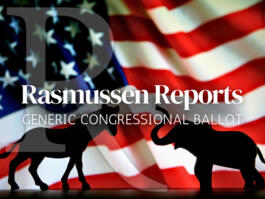Republicans Are More Eager to Vote This Year Than Democrats
Republicans are more enthusiastic than Democrats and independents about voting this November, but all Americans are more eager to vote than they were in the last mid-term elections.
The latest Rasmussen Reports national telephone and online survey finds that 70% of Likely Republican Voters say they are more likely to vote this year than they have been in past election years. That compares to 64% of Democrats and 51% of voters not affiliated with either major political party.
Among all Likely Voters, 62% say they are more likely to vote this year. Only six percent (6%) say they are less likely to do so, while 30% say they are just as likely to vote this November as in any other year. (To see survey question wording, click here.)
By comparison, in July 2014, 57% said they were more likely to vote that November compared to past elections. Enthusiasm was higher two years ago during the presidential campaign, with 67% who said they were more likely to vote.
Forty-eight percent (48%) of voters say they are more likely to vote in the next election for a member of the House or Senate who opposes President Trump’s agenda. Just half as many (24%) say they are less likely to vote for a Trump opponent. Twenty-two percent (22%) say a congressional incumbent’s support or opposition to the president will have no impact on their vote. This marks little change from August of last year.
(Want a free daily e-mail update? If it's in the news, it's in our polls). Rasmussen Reports updates are also available on Twitter or Facebook.
The survey of 1,000 Likely Voters was conducted on June 5-6, 2018 by Rasmussen Reports. The margin of sampling error is +/- 3 percentage points with a 95% level of confidence. Field work for all Rasmussen Reports surveys is conducted by Pulse Opinion Research, LLC. See methodology.
Democrats have taken the lead again on this week’s Rasmussen Reports Generic Congressional Ballot. Trump’s daily job approval rating remains slightly higher than Barack Obama’s was at this stage of his presidency.
Republicans currently control both the House and the Senate. The Democrats controlled both chambers for the first two years of Obama’s presidency, but Republicans won the majority in the House in the 2010 midterm elections.
The older the voter, the more enthusiastic they are about voting in the upcoming midterm elections. But those under 40 are the most likely to favor a member of Congress who has opposed the president’s agenda.
Black voters are more eager than whites and other minority voters to vote this November and are the strongest supporters of congressional incumbents who oppose Trump.
Sixty-five percent (65%) of Democrats are more likely to vote in the next election for a member of the House or Senate who opposes the president’s agenda. Thirty-two percent (32%) of GOP voters and 45% of unaffiliateds agree.
However, 73% of voters who Strongly Approve of Trump’s job performance are more likely to vote this year, compared to 65% of those who Strongly Disapprove of the job he is doing.
Even more voters now believe that Trump sets the agenda inside the Beltway, with the national media coming in a distant second.
Few voters believe the average congressional representative shares their views. But Democrats are more likely than Republicans to say their views are in line with the representatives in their own party.
Many Democrats and their allies in Hollywood and the media continue to attack the president in an unprecedented fashion. But few voters think Trump-bashing will pay off for his opponents in the next election.
Special Counsel Robert Mueller’s investigation of the 2016 election also appears to be driving Republicans to vote this year for candidates endorsed by the president.
Just 15% of all voters believe focusing on the president’s possible impeachment is a better campaign strategy for Democratic congressional candidates than focusing on policy areas where they disagree with Trump.
Additional information from this survey and a full demographic breakdown are available to Platinum Members only.
Please sign up for the Rasmussen Reports daily e-mail update (it’s free) or follow us on Twitter or Facebook. Let us keep you up to date with the latest public opinion news.
The survey of 1,000 Likely Voters was conducted on June 5-6, 2018 by Rasmussen Reports. The margin of sampling error is +/- 3 percentage points with a 95% level of confidence. Field work for all Rasmussen Reports surveys is conducted by Pulse Opinion Research, LLC. See methodology.
Rasmussen Reports is a media company specializing in the collection, publication and distribution of public opinion information.
We conduct public opinion polls on a variety of topics to inform our audience on events in the news and other topics of interest. To ensure editorial control and independence, we pay for the polls ourselves and generate revenue through the sale of subscriptions, sponsorships, and advertising. Nightly polling on politics, business and lifestyle topics provides the content to update the Rasmussen Reports web site many times each day. If it's in the news, it's in our polls. Additionally, the data drives a daily update newsletter and various media outlets across the country.
Some information, including the Rasmussen Reports daily Presidential Tracking Poll and commentaries are available for free to the general public. Subscriptions are available for $4.95 a month or 34.95 a year that provide subscribers with exclusive access to more than 20 stories per week on upcoming elections, consumer confidence, and issues that affect us all. For those who are really into the numbers, Platinum Members can review demographic crosstabs and a full history of our data.
To learn more about our methodology, click here.




